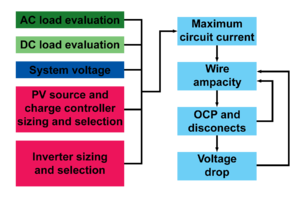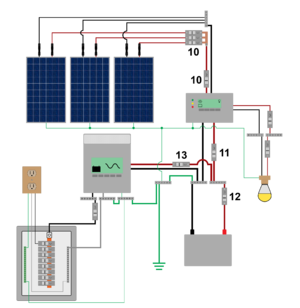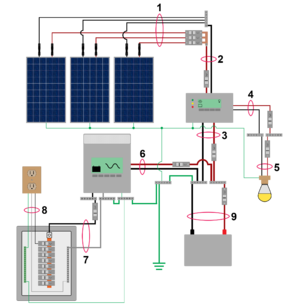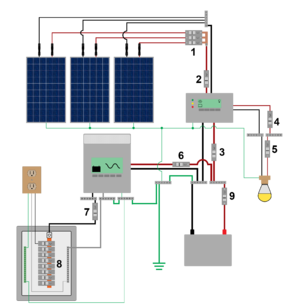Wire, overcurrent protection, and disconnect sizing and selection

Choosing the proper wire (conductor) size for a circuit is necessary to ensure that a system is safe and functions properly. In order to determine the appropriate wire size for a particular circuit there are four main considerations that must be evaluated in phases:
- Maximum circuit current
- Wire ampacity
- Overcurrent protection and disconnects
- Voltage drop
These phases will be carried out in this order. If a wire size meets the current requirements determined in Phase 2 but fails to meet either the overcurrent protection requirements in Phase 3 or the voltage drop requirements in Phase 4, then the wire size will have to be increased.
Contents
Phase 1: Maximum circuit current
The maximum circuit current for each circuit will vary depending upon the type of circuit. There are some circuits that may not exist in all PV systems, for example:
- If there is no inverter then there will be no inverter input, inverter output, or AC branch circuits.
- If the system has no DC lighting or loads, there will be no DC load circuits or DC branch circuits.
- If there is no combiner box then there will be no PV output circuit.
- If the inverter and charge controller are connected directly to the energy storage system, then there will be no energy storage circuit.
| Circuit | Maximum current calculation |
|---|---|
| (1) PV source circuit | = PV module Isc × Irradiance safety parameter |
| (2) PV output circuit | = Sum of the current for all PV source circuits |
| (3) Charge controller output circuit | = Current rating of the charge controller |
| (4) Charge controller load circuit | = Current rating of the charge controller lighting/load circuit |
| (5) DC branch circuit | =Sum of the power rating of all loads on the circuit from the DC load evaluation÷ circuit nominal voltage |
| (6) Inverter input circuit | = Final inverter continuous duty rating ÷ Low voltage disconnect parameter ÷ Inverter efficiency parameter |
| (7) Inverter output circuit | = Final inverter continuous duty rating ÷ Inverter AC voltage |
| (8) AC branch circuit | = Sum of the power rating of all loads on the circuit from the AC load evaluation ÷ nominal circuit voltage |
| (9) Energy storage circuit | = Larger of Inverter input circuit current or Charge controller charging circuit current |
Phase 2: Wire ampacity
All wires have a maximum current rating, referred to as ampacity, that corresponds to their diameter and the conditions under which the wire will be used. If this maximum ampacity value is exceeded for the conditions of use, it could cause the wire to overheat and potentially start a fire. All wires must be sized to ensure that they can handle the maximum amount of current the circuit could ever be expected to carry and must be protected by an overcurrent protection device (OCPD).
PV source and PV output circuits
The minimum wire size can be determined using the following steps:
- Determine the ambient temperature correction factor based upon the maximum ambient temperature for outdoor circuits and maximum indoor temperature for indoor circuits using the ambient temperature correction factor table. High temperatures increase the resistance of the wire and reduce its current carrying capacity.
Note: Wires, nor conduit, should be located less than 2.25 cm from a roof surface in direct sunlight. This will increase temperatures as much as 33°C and can lead to the ampacity and temperature rating of wires to be exceeded. - Determine the conduit fill correction factor based upon the number of wires in the conduit using the conduit fill correction factor table. More than three wires - not including any wires related to the grounding system - in a conduit will reduce the current carrying capacity of each wires due to reduced cooling.
- Determine the total wire correction parameter based upon the smaller of: the Ambient temperature correction multiplied by the Conduit fill correction factor or .8 (a safety factor from the US National Electrical code).
- Determine minimum wire ampacity. Divide the maximum circuit current (Phase 1) by the total wire correction factor
- Select a wire (conductor) size with a maximum rated ampacity equal to or above the minimum wire ampacity calculated in the previous step using the allowable wire ampacity table. This table has two different temperature columns - 60°C, 75°C / 90°C – that correspond to different wire types. This temperature corresponds to the maximum temperature rating of the wire type, which should be labeled on the exterior of the wire and readily available from the product provider. Most wires have a dual rating of 60°C (wet) / 75°C (dry), 75°C wet/dry, or 90°C wet/dry rating. If 60°C wire is used in the circuit, the 60°C column will have to be used.
| Total wire correction parameter | = Smaller of (Ambient temperature correction factor (Step 1) × Conduit fill correction factor (Step 2)) or .8 |
|---|
| Minimum wire ampacity | = Maximum circuit current (Phase 1) ÷ Total wire correction parameter (Step 3) |
|---|
All other circuits
All wires have a maximum current rating, referred to as ampacity, that corresponds to their diameter and the conditions under which the wire will be used. If this maximum ampacity value is exceeded for the conditions of use, it could cause the wire to overheat and potentially start a fire. All wires must be sized to ensure that they can handle the maximum amount of current the circuit could ever be expected to carry and must be protected by an overcurrent protection device (OCPD).
- Determine the ambient temperature correction factor based upon the maximum ambient temperature for outdoor circuits and maximum indoor temperature for indoor circuits using the ambient temperature correction factor table. High temperatures increase the resistance of the wire and reduce its current carrying capacity.
- Determine the conduit fill correction factor based upon the number of wires in the conduit using the conduit fill correction factor table. More than three current carrying conductors (wires) - not including any wires related to the grounding system - in a conduit will reduce the current carrying capacity of each wires due to reduced cooling.
- Determine the total wire correction parameter based upon the Ambient temperature correction multiplied by the Conduit fill correction factor.
- Determine minimum wire ampacity. Divide the maximum circuit current (Phase 1) by the total wire correction factor
- Select a wire (conductor) size with a maximum rated ampacity equal to or above the minimum wire ampacity calculated in the previous step using the allowable wire ampacity table. This table has two different temperature columns - 60°C, 75°C / 90°C – that correspond to different wire types. This temperature corresponds to the maximum temperature rating of the wire type, which should be labeled on the exterior of the wire and readily available from the product provider. Most wires have a dual rating of 60°C (wet) / 75°C (dry), 75°C wet/dry, or 90°C wet/dry rating. If 60°C wire is used in the circuit, the 60°C column will have to be used.
| Total wire correction parameter | = Ambient temperature correction factor (Step 1) × Conduit fill correction factor (Step 2) |
|---|
| Minimum wire ampacity | = Maximum circuit current (Phase 1) ÷ Total wire correction parameter (Step 3) |
|---|
Phase 3: Overcurrent protection and disconnects

No wire should be exposed to current in excess of its rated capacity under the conditions of use. If a power source that a circuit is connected to can supply more current than the rated ampacity of a wire, then an overcurrent protection device must be used to prevent it from overheating and starting a fire. In off-grid systems overcurrent protection devices are also typically used as power source disconnects and equipment disconnects. Residual current devices should be sized using this same method if they are intended to function as an OCPD, if not they only need to be larger than the maximum current of the circuit to ensure that they do not accidentally trip.
Ground fault protection devices incorporate a breaker, but these GFPDs only come in a few sizes and it is common to use a GFPD with a breaker that is substantially larger than the ampacity of the wire for this reason. An additional breaker is therefore commonly used as the power source disconnect, because using the GFPD would mean that the DC system bond would be removed each time the breaker was used as a disconnect, which is not a safe practice.
There are some cases in which an overcurrent protection device is not required because another overcurrent protection device protects that circuit against excessive current or the power source cannot supply current that would exceed the rated capacity of the wire. Not all systems are wired the same - some designs will require additional OCPDs and others will require fewer.
| Circuit | |
|---|---|
| (1) PV source circuit OCPD | Required if the system has more than two parallel strings of PV modules. Can also serve as the required power source disconnect - see (10) in the image. |
| (2) PV output circuit OCPD | A power source disconnect - typically a breaker - is required for the PV source. If the PV source circuits have breakers they can meet this need if they are located near the charge controller. Can also serve as the required power source disconnect - see (10) in the image. |
| (3) Charge controller output circuit OCPD | The wires between the charge controller and the energy storage system must be protected by an OCPD. There should also be a power source disconnect for the energy storage system and an equipment disconnect for the charge controller. Both of these requirements can be fulfilled by installing a breaker - see (11) in the image. |
| (4) Charge controller load circuit OCPD | The wires between the charge controller and any lighting/load only need to be protected by an OCPD if the charge controller can supply current that exceeds the rating of the wires. This is typically not the case. |
| (5) DC branch circuit OCPD | The wires between the charge controller and any lighting/loads only need to be protected by an OCPD if the charge controller can supply current that exceeds the rating of the wires. This is typically not the case. |
| (6) Inverter input circuit OCPD | The wires between the inverter and the energy storage system must be protected by an OCPD. There should also be a power source disconnect for the energy storage system and an equipment disconnect for the inverter. Both of these requirements can be fulfilled by installing a breaker - see (13) in the image. |
| (7) Inverter output circuit OCPD | The wires between the inverter and any loads only need to be protected by an OCPD if the inverter can supply current that exceeds the rating of the wires. This is often not the case with smaller inverters, especially those with a 220 V nominal voltage. It is recommended that a residual current device (RCD) with an integrated breaker is used on the output of the inverter to increase system safety or on each individual circuit. It should be located before the AC system bonding jumper to avoid accidental tripping (activation). |
| (8) AC branch circuit OCPD | The wires between the inverter and any loads only need to be protected by an OCPD if the inverter can supply current that exceeds the rating of the wires. This is often not the case with smaller inverters, especially those with a 220 V nominal voltage. If there is no residual current device (RCD) on the output circuit of the inverter, it is recommended that one be added to AC circuit or outlet. |
| (9) Energy storage circuit OCPD | The wires between the energy storage system and any other component must be protected by an OCPD - charge controllers, inverters, DC-DC converters, low voltage disconnects, DC appliances. There also must be a power source disconnect for the energy storage system. Both of these requirements can be fulfilled by installing a breaker or a fused disconnect - see (12) in the image. Larger systems are typically designed like in the wiring diagram with one single circuit running from the energy storage system to common DC busbars to reduce wire and OCPD costs - in this case there is an energy storage circuit. Smaller systems often connect the charge controller and inverter directly to the energy storage system independently - in this case there is no energy storage circuit. |
The appropriate overcurrent protection device size can be determined by:
- Overcurrent protection devices (OCPDs) are thermally (heat) activated. If an OCPD operates for an extended period of time, it will begin to generate heat that could potentially cause it to accidentally activate. Thus, if a circuit will operate for more than three hours continuously, which all circuits in an off-grid system likely will at some point, then the overcurrent protection device size will be increased to avoid any issues. The maximum circuit current calculated in Phase 1 is multiplied by the therefore multiplied by the continuous duty safety parameter of 1.25 unless the OCPD is rated for continuous duty.
- There are standard OCPD sizes that both the NEC and IEC recognize. The OCPD size should be the next largest size after the minimum OCPD size calculated in Step 1. Except for the following wire sizes: 15 A maximum for 2.5 mm² / 14 AWG. 20 A maximum for 4 mm² / 12 AWG. 30 A maximum for 6 mm² / 10 AWG.
- Standard international OCPD sizes: 1 A, 2 A, 4 A, 6 A, 10 A, 13 A, 16 A, 20 A, 25 A, 32 A, 40 A, 50 A, 63 A, 80 A, 100 A, 125 A, 150 A, 175 A, 200 A, and 225 A.
- Standard US OCPD sizes per US NEC: 15, 20, 25, 30, 35, 40, 45, 50, 60, 70, 80, 90, 100, 110, 125, 150, 175, 200, 225, 250, 300, 350, 400, 450, 500, 600, 700, 800, 1000, 1200, 1600, 2000, 2500, 3000, 4000 5000, and 6000 A. Additional standard fuse sizes are 1, 3, 6, 10, and 601 A.
- Standard international OCPD sizes: 1 A, 2 A, 4 A, 6 A, 10 A, 13 A, 16 A, 20 A, 25 A, 32 A, 40 A, 50 A, 63 A, 80 A, 100 A, 125 A, 150 A, 175 A, 200 A, and 225 A.
- Verify that the chosen OCPD size from Step 2 will protect the wire size chosen in Phase 2 from excessive current under the conditions of use. The current rating of the chosen OCPD size (Step 2) must be less than the calculated maximum current under conditions of use unless the calculated maximum current under conditions of use is between standard OCPD values, in this case the next largest OCPD size is used from the list of standard OCPD sizes. If the current rating of the chosen OCPD size is larger than the maximum OCPD size under conditions of use, then the wire size must be increased to until it passes this test.
Maximum current under conditions of use = Wire ampacity from allowable wire ampacity table × Total wire correction parameter (Phase 2). Determine the maximum OCPD size under conditions of use.
Maximum OCPD size under conditions of use = Can be equal to the maximum current under conditions of use. If between standard OCPD sizes, the next largest OCPD is used. Except for the following wire sizes: 15 A maximum for 2.5 mm² / 14 AWG. 20 A maximum for 4 mm² / 12 AWG. 30 A maximum for 6 mm² / 10 AWG. Verify OCPD under conditions of use = The current rating of the chosen OCPD (Step 2) must be less than or equal to the maximum OCPD size under conditions of use
| Minimum OCPD size | = Maximum circuit current (Phase 1) × 1.25 |
|---|
Example 1: Step 1,2 suggest a 30 A breaker. Phase 2 calculated a 10 AWG / 6 mm² for the circuit. The ampacity rating for this wire is 35 A at 75°C. The total wire correction parameter (Phase 2) is .65 Can the 10 AWG / 6mm² wire be used?
- Maximum current under conditions of use = 35 A × .65
- Maximum current under conditions of use = 22.75 A
- The next largest breaker is a 25 A breaker, but this breaker would be too small for the circuit. The wire size needs to be increased to the next largest size of wire 8 AWG / 10mm²
Example 2: Step 1,2 suggest a 30 A breaker. Phase 2 calculated a 10 AWG / 6 mm² for the circuit. The ampacity rating for this wire is 35 A at 75°C. The total wire correction parameter (Phase 2) is .8 Can the 10 AWG / 6mm² wire be used?
- Maximum current under conditions of use = 35 A × .8
- Maximum current under conditions of use = 28 A
- The next largest breaker is a 30 A breaker, which was the suggested breaker size (Step 1,2). 10 AWG / 6mm² and a 30 A breaker is acceptable.
Phase 4: Voltage drop
All wires should be sized to make sure that the resistance of the wire will not create an excessive voltage drop that can lead to lost PV production, improper battery charging, and loads that do not function properly. It is important to be conservative with voltage drop percentages as there are many other parts of circuits that further increase voltage drop that are not included in standard voltage drop calculations including any wire terminals, twist-on wire connectors, busbars, or connections on component terminals.
If the voltage drop for the wire chosen in Phase 2 for a particular circuit is not within the recommended values, then using a larger sized wire should be considered. Increasing the wire size will not affect any other part of this process; the calculated OCPD size can remain the same.
The formula for calculating voltage drop is:
| Voltage drop | = 2 x Circuit current x One-way circuit length (m) x Resistance (Ω/Km) ÷ 1000 |
|---|
The most important value is the percentage voltage drop for the circuit. This is calculated using the formula:
| Percentage voltage drop | = Voltage drop ÷ Nominal circuit voltage x 100 |
|---|
Recommended circuit voltage drop values
The table below has recommended maximum voltage drop values for various circuits. It is important to note that other components in a circuit - terminals, fuses, breakers - add resistance and will increase voltage drop as well, therefore it is important to be conservative.
Note: Not all PV systems are wired the same. These voltage drop values are for total circuit length between one component and another. It is common to have DC busbars that have one single set of wires that runs to the energy storage system and connect to a positive and negative DC busbar that serve as a point of connection for the inverter and charge controller. In this case it is necesary to calculate the total voltage drop between the charge controller and the energy storage system, rather than just to the busbar.
| Circuit | Maximum recommended voltage drop |
|---|---|
| PV source to charge controller | 3% |
| Charge controller to energy storage | 1.5% |
| Energy storage to inverter | 1.5% |
| DC lighting circuits | 5% |
| DC load circuits | 3% |
| AC load and lighting circuits | 2% |
Ambient temperature correction factor table
For ambient temperatures other than 30°C (86°F), multiply the allowable ampacities specified in the ampacity tables by the appropriate correction factor shown below.[1]
| Ambient temperature (°C) | Temperature rating of wire | ||
|---|---|---|---|
| 60°C | 75°C / 90°C | ||
| 10 or less | 1.29 | 1.20 | |
| 11–15 | 1.22 | 1.15 | |
| 16–20 | 1.15 | 1.11 | |
| 21–25 | 1.08 | 1.05 | |
| 26–30 | 1.00 | 1.00 | |
| 31–35 | 0.91 | 0.94 | |
| 36–40 | 0.82 | 0.88 | |
| 41–45 | 0.71 | 0.82 | |
| 46–50 | 0.58 | 0.75 | |
| 51–55 | 0.41 | 0.67 | |
| 56–60 | — | 0.58 | |
| 61–65 | — | 0.47 | |
| 66–70 | — | 0.33 | |
Conduit fill correction factor table
| Number of Conductors | Percent of ampacity value |
|---|---|
| 1-3 | 100 |
| 4–6 | 80 |
| 7–9 | 70 |
| 10–20 | 50 |
| 21–30 | 45 |
| 31–40 | 40 |
| 41 and above | 35 |
Conductor ampacity table
For 1-3 copper conductors in conduit with a 30°C ambient temperature.[2]
| AWG size | Area (mm²) | Metric equivalent (mm²) | 60°C | 75°C / 90°C |
|---|---|---|---|---|
| 14 | 2.08 mm² | 2.5 mm² | 15 | 20 |
| 12 | 3.31 mm² | 4 mm² | 20 | 25 |
| 10 | 5.26 mm² | 6 mm² | 30 | 35 |
| 8 | 8.37 mm² | 10 mm² | 40 | 50 |
| 6 | 13.3 mm² | 16 mm² | 55 | 65 |
| 4 | 21.2 mm² | 25 mm² | 70 | 85 |
| 3 | 26.7 mm² | — | 85 | 100 |
| 2 | 33.6 mm² | 35 mm² | 95 | 115 |
| 1 | 42.4 mm² | 50 mm² | 110 | 130 |
| 1/0 | 53.5 mm² | — | 125 | 150 |
| 2/0 | 67.4 mm² | 70 mm² | 145 | 175 |
| 3/0 | 85 mm² | 95 mm² | 165 | 200 |
| 4/0 | 107 mm² | 120 mm² | 195 | 230 |
Wire resistance values
A simplified chart with resistances for copper wires.[3]
| Copper resistance at 75°C | |||
|---|---|---|---|
| Size AWG | Area | Metric equivalent | Ω/km |
| 18 | 0.823 mm² | 1 mm² | 26.5 Ω |
| 16 | 1.31 mm² | 1.5 mm² | 17.3 Ω |
| 14 | 2.08 mm² | 2.5 mm² | 10.7 Ω |
| 12 | 3.31 mm² | 4 mm² | 6.73 Ω |
| 10 | 5.261 mm² | 6 mm² | 4.226 Ω |
| 8 | 8.367 mm² | 10 mm² | 2.653 Ω |
| 6 | 13.30 mm² | 16 mm² | 1.671 Ω |
| 4 | 21.15 mm² | 25 mm² | 1.053 Ω |
| 3 | 26.67 mm² | — | 0.833 Ω |
| 2 | 33.62 mm² | 35 mm² | 0.661 Ω |
| 1 | 42.41 mm² | 50 mm² | 0.524 Ω |
| 1/0 | 53.49 mm² | — | 0.415 Ω |
| 2/0 | 67.43 mm² | 70 mm² | 0.329 Ω |
| 3/0 | 85.01 mm² | 95 mm² | 0.2610 Ω |
| 4/0 | 107.2 mm² | 120 mm² | 0.2050 Ω |

